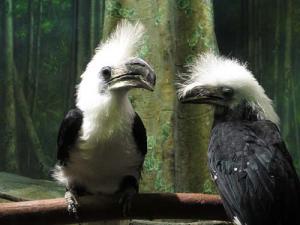February 21, 2013
 Male called “pushy” in this white-crested hornbill couple. Franklin Park Zoo photo
Male called “pushy” in this white-crested hornbill couple. Franklin Park Zoo photo
While many humans spent their hard-earned cash on chocolate, flowers, heart-shaped balloons and other Valentine’s Day paraphernalia last week, many animals at the Franklin Park Zoo, and around the world for that matter, spent the day of love expressing themselves physically. They just do it – they’re not shy.
The post-Valentine’s Day lecture, Sex at the Zoo, returned this year, educating lovebirds and reporters alike in the ways of animal courtship and mating. Jennifer Gresham, Zoo New England’s Director of Education, hosted the evening that began innocently enough.
“If you’re going to take one lesson away tonight, I would say think about what you really want in your mate,” she said.
The innocuous relationship advice stopped there.
“These are some things that animals may or may not think about but that come into play when they are selecting their mate,” Gresham explained. “Whether it’s for life or just for the moment or for three hours or for three seconds or whatever it is.”
Many animals use their noses to sniff out their mates including tapirs, bristle-tailed porcupines, giraffes and, on a domesticated level, cats. Tapirs and bristle-tailed porcupines have large noses in order to pick up on their love’s pheromones. Neither can see very well in the rainforest, their natural habitat.
Cats and giraffes use the Flehmen response to pick up odors in the air. They curl their upper lip, bringing the scent back to the Jacobson’s organ, allowing them to determine if a potential mate is near and in heat.
The scent that these animals sniff for is not by Chanel or even Old Spice.
“Urine’s a big theme here,” Gresham noted.
A strong urine scent is often the key in finding a mate’s whereabouts.
Trust is another, less pungent, theme in the animal kingdom. Females must be receptive to males in order to mate and must be impressed in some way. The female hornbill, for example, is walled into a tree by her mate, molts and relies solely on her male counterpart to feed her through a slit in the tree while she lays and sits on her eggs. The process takes four months.
Franklin Park Zoo has a rather dodgy male in its keep.
“For some reason, he’s not trustworthy,” Gresham told the audience of the zoo’s white-crested hornbill pair. “This is the second female we’re working with; I think he’s pushy.”
Gresham shared facts, photos, videos and some audio takes of animal courtship rituals including ocelot calls in heat (think of your cat, but worse); blue-footed boobies, whose male population dance to attract a mate; and a male camel inflating his doula (the soft palate in his mouth) to show dominance over other males and his availability to mate.
The zoo and its sister facility, the Stone Zoo in Stoneham, take great care in replicating native habitats, natural diets and, of course, ideal mating conditions. All of their animals are born in North America and many acclimate well to New England weather. Some, such as the wild dogs, have access to their outdoor exhibit areas year round, though “it’s a day-to-day call,” Gresham said.
“It’s fun for people to think about what animals do and how we’re really not all that different,” she said, laughing. “And how some of our customs are replicated in the animal world.”
So if ever you find yourself the target of a gorilla undressing you with his eyes or the witness of shameless bonobo love fests at the zoo, don’t be offended; the mood is right for them. And they are not shy.
For more information, visit zoonewengland.org.


